Exploring True Detective, S1:E1: “The Long Bright Dark”
Before I begin examining Season One, I want to mention a few things:
Please read my introductory post if you haven’t already.
If you have not watched the entire first season, don’t read these posts. I will be getting into spoilers throughout and in some cases may reference other episodes in the first season.
My research will be minimal. I’ll consult some outside sources, but primarily I want to explore how the show affects me (and maybe you, too), and what we can take away from it.
Again, I want to thank my good friend Jan Willis for collaborating with me on this project. Much of what follows comes from his wise and valuable contributions.
Thank in advance you for reading.
Episode 1: “The Long Bright Dark”
The first episode introduces us to Louisiana State Police homicide detectives Marty Hart (Woody Harrelson) and Rust Cohle (Matthew McConaughey) investigating the brutal murder of a young woman named Dora (sometimes called Dori) Lange in 1995. Although driven to find and apprehend the killer, Rust doesn’t fit in with the police department at large or with his partner Marty. Rust’s pessimistic view of life and his unsettled past slowly emerge as the season progresses, as does Marty’s troubled home life. Much of Season One jumps from 1995 to 2012 where Marty and Rust are interviewed separately by two Louisiana State Police CID investigators, Detectives Maynard Gilbough (Michael Potts) and Thomas Papania (Tory Kittles), looking for answers to a current unsolved crime eerily similar to the Lange case.
SPOILERS BEGIN
With the very first shot we see a night sky as the backdrop to what appears to be a dark shape carrying someone or something. The next shot reveals a close up of some type of brush fire followed by a long shot of a vast landscape set ablaze with a few trees nearby and a body of water (a bayou) in the foreground. This vague sequence doesn’t tell us much, but it serves as a visual introduction to the series, preparing us to recognize that we - like the detectives - aren’t seeing everything, yet what we can witness is mostly hidden in the dark. Deep darkness engulfs this large swath of land, and when we understand that the scant illumination we can see is an accomplice of the dark, we begin to learn something of the frustration and helplessness felt by Marty and Rust.
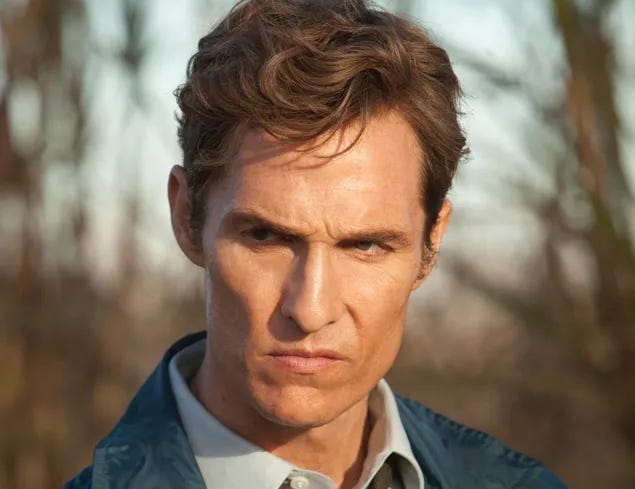
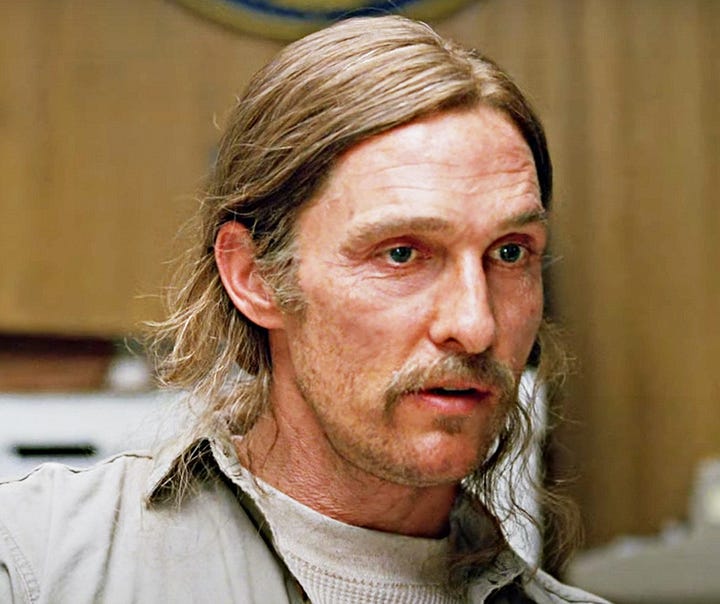
As mentioned in my introductory post, True Detective contains many similarities to the writing of William Faulkner, including unannounced shifts in time and place. Most of these transitions are fairly easy to determine. We know it’s 1995 when we see Rust clean-shaven rather than sporting his long hair and mustache from 2012.
But we also see snatches of events that haven’t yet happened, one of which I will describe in a moment. This is visually what Faulkner does on the page, yet in a novel like The Sound and the Fury, times and places are much more difficult to determine, often changing two or more times within the same paragraph.1 In True Detective the visual medium makes it fairly easy to determine where and when we are. But you have to keep up.
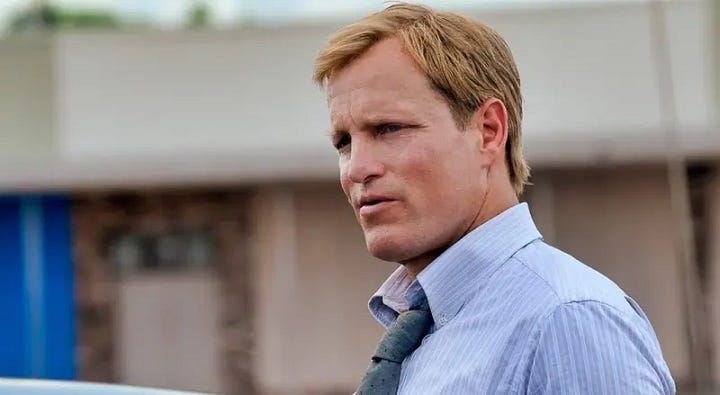
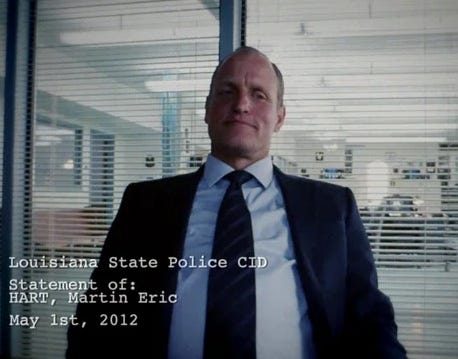
Next, Marty is being interviewed in 2012 by officers Gilbough and Papania. Marty looks older and heavier than he does in the show’s promotional material and even in the haunting title sequence. He’s got a receding hairline, and his seated posture suggests both superiority and apprehension. Marty is asked, “What did you think, paired up with him?” Marty’s response: “What did I think? Well, you don’t pick your parents, and you don’t pick your partner.” This answer suggests that fate brought them together, that their pairing was uncontrollable or “in the stars.” His reply also suggests that Marty would never have chosen Rust had it been up to him. As the episode progresses, we think it’s simply because Rust is weird and “aloof” (as Marty later describes him), but we will learn that there’s much more to it.
I suspect the reason we meet Marty first is that he gives the audience a sense of normalcy that Rust would not. We need someone to compare Rust to, especially during these opening minutes. Even if we (rightfully) believe that Marty is not a reliable narrator, he seems normal (or what passes for normal).
But even before we meet Rust, Marty tells the investigators and us what we need to know: “Seemed a bit raw-boned to me. Edgy.” Nobody on the force knew Rust. He came from Texas and acted mysterious, strange. “Rust would pick a fight with the sky, he didn’t like its shade of blue.” This response potentially says a lot about Rust’s character. If the shade of blue was too light for Rust’s dark worldview, he might actually argue with a God he doesn’t believe exists, insisting that the sky should be darker, always darker. This thought also brings to mind the dark blue of the episode’s opening moments.
Next we have one of those Faulkner moments, a flashback, supposedly from Marty’s memories while he’s being interviewed in 2012. Here we see Rust at night, carrying flowers, stumbling up to a house, a moment that will become clearer soon. When the scene later returns, we wonder why that image of Rust comes to Marty’s mind first.
But now it’s time for Gilbough and Papania to interview Rust. When one of the cops warns Rust not to smoke during the interview, Rust responds, “Don’t be assholes. You want to hear this or not?” When they hand him a coffee mug for his cigarette ashes, Rust moves it to where he wants it to be, signaling that he’s calling the shots, in complete control of everything that will take place in the interview, something he could not easily do in 1995 as a subordinate to Marty. It’s a small moment, but it prepares us for understanding the development of Rust’s attitude later.
In the next flashback we see the town of Erath. (I wasn’t aware this is a real town south of Lafayette in Vermilion Parish, Louisiana, population approx. 2,000.) It’s 1995 and the contrast from their appearances in 2012 is jarring. It’s interesting to see that 1995 shows them both fairly clean-cut, although a bit scruffy. Both men wear ties: Marty’s straight and neat, Rust’s loose and crooked.
Although he walks behind Marty (the lead investigator), Rust approaches the body of the young woman (Dori) first. Marty defers to him, saying, “Tell me what you see.” It’s not necessarily because the death scene is so distasteful that Marty allows Rust to take the lead here, but Marty understands that Rust is more knowledgeable about ritual murders. Yet later, when Rust states “This is gonna happen again,” Marty accuses him of jumping to conclusions, “bending the narrative to support it (Rust’s ideas).” This could be due to Marty’s lack of understanding of the killer’s mind, something that clearly does not baffle Rust, thus giving his partner an advantage, or because it doesn’t fit in with Marty’s ideas of objective information based on the scant facts they have. We’ll see this conflict play out several times over the course of the series. The question becomes one not of competition, per se, but how each man tries to understand the other. Will this bring them together or force them further apart?
This entire sequence in this conversation (and many others to come) is fascinating in several ways: workplace competition, sharing (or lack of sharing) of information, differences in worldviews, and much more. Marty knows Rust desperately needs the company of people and, to Marty’s credit, he invites him to his home for dinner.
The dinner scene is a crucial moment in the relationship between the two men. Yes, part of Marty’s idea is to get Rust to relax around (what Marty thinks of as) a stable home environment, to talk about things having nothing to do with murder, violence, and all things horrific. Just a normal dinner with normal people.
Until Rust shows up drunk.
But before that happens, remember one of the flashbacks: We see Rust walking across Marty’s yard at night. Actually, staggering might be a more appropriate word. It’s significant that Marty is holding a bouquet of flowers pointed down to the ground, and, as we learn, this day is the anniversary of his young daughter’s death. This, and his nervousness at meeting Marty’s family, explains why Rust has gotten loaded before his arrival. Marty is, of course, shocked, partly because Rust had previously stated that he doesn’t drink, but even more because Rust has violated a tenet of Southern hospitality: When invited to someone’s home, you arrive on time in something of a presentable fashion and act in a gracious manner, not blitzed to the gills.
Aghast that his partner has shown up drunk, Marty berates him privately. “I didn’t mean to,” Rust says. Marty instantly regrets his good-faith invitation to Rust, and, making things worse, Marty’s young daughters Audrey (Madison Wolfe) and Macie (Meghan Wolfe) are witnessing a drunken stranger in their home.
Concerned the evening may turn into a total disaster, Marty tells Rust he’ll make a phone call to the police station, asking someone to give Rust a call in a few minutes, clearing the way for him to make a somewhat dignified exit before embarrassing himself further. Yet when the call comes, Rust - enjoying talking with Maggie - decides to stay awhile, aggravating Marty even further. What we and Marty don’t know is how significant and devastating this moment will play out later in the series.
During the dinner conversation, Rust quietly tells Maggie about his daughter, saying “she passed,” rather than "she died.” This could simply be a polite way of discussing a painful and sensitive matter, especially with someone you’ve just met. But as the exchange continues, we notice not only that Rust is in no hurry to leave, but also that he and Maggie seem to have struck a chord, all to the everlasting consternation of Marty. Part of this dynamic involves the realization that Maggie is able to draw things out of Rust that she can’t draw out of her husband. Again, this is a quiet but crucial moment, one of the series’ most important ones.
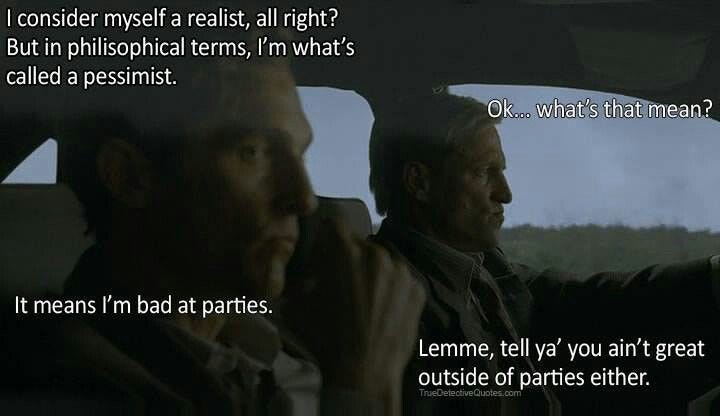
This first episode also provides a look into Rust’s philosophy and worldview. After their visit to the crime scene, Rust reflects to Marty, “People out here, it’s like they don’t even know the outside world exists… It’s all a ghetto.” This comment reflects what Rust believes is an ignorance not only of the world, but the things controlling it, bringing to mind Ephesians 6:12 (ESV), “For we do not wrestle against flesh and blood, but against the rulers, against the authorities, against the cosmic powers over this present darkness, against the spiritual forces of evil in the heavenly places.”
Perhaps recalling this verse (or others like it) causes Marty to respond, “You’re a Christian, yeah?”
Rust: “No.”
Marty: “The cross?” (which Marty saw on the wall in Rust’s apartment)
Rust: “A form of meditation… I contemplate the moment in the garden, the idea of allowing your own crucifixion… I think human consciousness is a tragic misstep in evolution. We became too self-aware. Nature created an aspect of nature separate from itself. We are creatures that should not exist by natural law.”2
We could spend hours examining just this part of Rust’s philosophy/worldview, but I don’t want these posts to extend into tomes, so I’ll keep it brief: Rust denies (or twists) any aspect of a biblical concept of God, including God’s goodness, sovereignty, omnipotence, and more, yet modifies concepts of nature (thus touching on creation), the Garden of Eden, Christ’s crucifixion sacrifice, and more to fit his own philosophy. Earlier Marty accuses Rust of bending the evidence of the Dori Lange murder to fit his theories of the murderer and his motives. Perhaps Marty recognizes that Rust is doing the same thing to the concepts of biblical Christianity that many people (especially in the South) would at least acknowledge, even if they don’t consistently live by them.
Rust’s ideas also call to mind Isaiah 5:20 (ESV):
Woe to those who call evil good
and good evil,
who put darkness for light
and light for darkness,
who put bitter for sweet
and sweet for bitter!
In the New Testament, such a belief is referred to as the unpardonable sin of blasphemy against the Holy Spirit. Matthew 12:31-32 (ESV) states:
31 Therefore I tell you, every sin and blasphemy will be forgiven people, but the blasphemy against the Spirit will not be forgiven. 32 And whoever speaks a word against the Son of Man will be forgiven, but whoever speaks against the Holy Spirit will not be forgiven, either in this age or in the age to come.
Rust is in a very dark place. Although he may have read about them, Marty has probably never encountered such thoughts personally, especially coming from someone sitting next to him in the car. Marty has no idea how to respond to what he’s just heard. It’s completely beyond his experience. Even if he did, Rust might reiterate his previous comment, “People out here, it’s like they don’t even know the outside world exists…” in Marty’s direction.
This conflict of worldviews is essential in understanding and appreciating True Detective. Obviously Marty and Rust are seeking to solve a crime, but they’re also trying to grapple with fundamental questions about existence, the world, and life. I’ll touch on more of these as we continue, but this series and what it reaches for is huge.
Yet Marty provides a moment of humor: “My luck I picked today to get to know you.”
There’s much more to this episode, including the introduction of Reverend Tuttle (Jay O. Sanders), first cousin of the governor, the introduction of court stenographer Lisa Tragnetti (Alexandra Daddario) as she drops off a stack of depositions to Marty at work, a report of a missing girl from five years earlier, information from Charlie (Brad Carter), Dori’s ex-husband in prison, a girl telling police she’d been chased in the woods by a “green-eared spaghetti monster,” and much more.
Thanks for reading. The comments are open, so feel free to share your thoughts.
To make things more complicated, Faulkner refers to some characters by more than one name and two different people in the story are named Quentin, a man, one a woman.
Much of Rust’s lines here and elsewhere are either inspired by (or plagiarized from) the published writings of Thomas Ligotti, especially from his book The Conspiracy Against the Human Race. Those who are interested can read more about the plagiarism controversy connected with True Detective.





